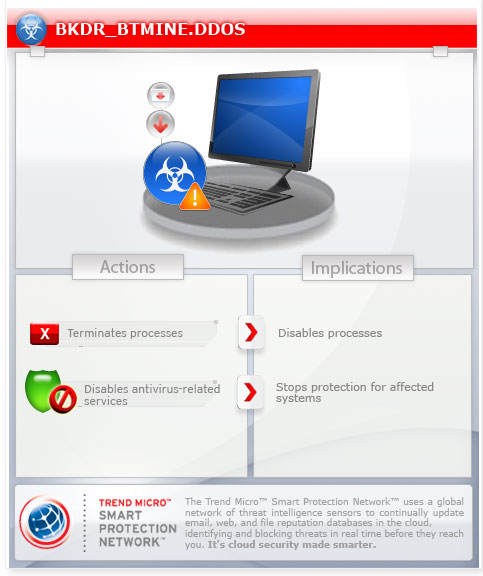BKDR_BTMINE.DDOS
Trojan:Win32/Teniel (Microsoft); Trojan.Gen.2 (Symantec); Trojan.Win32.Scar.enzn (Kaspersky)
Windows 2000, Windows XP, Windows Server 2003


Threat Type: Backdoor
Destructiveness: No
Encrypted: Yes
In the wild: Yes
OVERVIEW
This backdoor is a part of a Bitcoin mining malware. It is used to perform DDoS attacks and aids other component malware in stealing Bitcoins from targeted entities.
To get a one-glance comprehensive view of the behavior of this Backdoor, refer to the Threat Diagram shown below.

This backdoor contains a list of IP addresses that it tries to connect to in order to send receive information, download other malware, get a new list of IP addresses, and get a list of sites to launch DDoS attacks.
This malware is a part of a package that generate BitCoins. Its component malware BKDR_BTMINE.DDOS performs DDOS attacks against targeted entities.
This backdoor may be downloaded by other malware/grayware/spyware from remote sites. It may be unknowingly downloaded by a user while visiting malicious websites.
TECHNICAL DETAILS
1,032,704 bytes
EXE
Yes
01 Sep 2011
Terminates processes, Connects to URLs/IPs
Arrival Details
This backdoor may be downloaded by other malware/grayware/spyware from remote sites.
It may be unknowingly downloaded by a user while visiting malicious websites.
Installation
This backdoor drops the following copies of itself into the affected system:
- %Windows%\update.7.1\svchostdriver.exe
(Note: %Windows% is the Windows folder, which is usually C:\Windows or C:\WINNT.)
It creates the following folders:
- %Windows%\update.7.1
(Note: %Windows% is the Windows folder, which is usually C:\Windows or C:\WINNT.)
Autostart Technique
This backdoor registers itself as a system service to ensure its automatic execution at every system startup by adding the following registry entries:
HKEY_LOCAL_MACHINE\SYSTEM\CurrentControlSet\
Services\ddservice
Type = "10"
HKEY_LOCAL_MACHINE\SYSTEM\CurrentControlSet\
Services\ddservice
Start = "2"
HKEY_LOCAL_MACHINE\SYSTEM\CurrentControlSet\
Services\ddservice
ErrorControl = "0"
HKEY_LOCAL_MACHINE\SYSTEM\CurrentControlSet\
Services\ddservice
ImagePath = "%Windows%\update.7.1\svchostdriver.exe srv"
HKEY_LOCAL_MACHINE\SYSTEM\CurrentControlSet\
Services\ddservice
DisplayName = "ddservice"
HKEY_LOCAL_MACHINE\SYSTEM\CurrentControlSet\
Services\ddservice
ObjectName = "LocalSystem"
HKEY_LOCAL_MACHINE\SYSTEM\CurrentControlSet\
Services\ddservice\Security
Security = "{hex values}"
HKEY_LOCAL_MACHINE\SYSTEM\CurrentControlSet\
Services\ddservice\Enum
0 = "Root\LEGACY_DDSERVICE\0000"
HKEY_LOCAL_MACHINE\SYSTEM\CurrentControlSet\
Services\ddservice\Enum
Count = "1"
HKEY_LOCAL_MACHINE\SYSTEM\CurrentControlSet\
Services\ddservice\Enum
NextInstance = "1"
It adds the following registry entries to enable its automatic execution at every system startup:
HKEY_LOCAL_MACHINE\SOFTWARE\Microsoft\
Windows\CurrentVersion\Run
ddsoft = "%Windows%\update.7.1\svchostdriver.exe"
It adds and runs the following services:
- HKEY_LOCAL_MACHINE\SYSTEM\CurrentControlSet\Services\ddservice
Other System Modifications
This backdoor adds the following registry keys:
HKEY_LOCAL_MACHINE\SOFTWARE\ddsoft
It adds the following registry entries:
HKEY_LOCAL_MACHINE\SOFTWARE\ddsoft
close = "0"
HKEY_LOCAL_MACHINE\SOFTWARE\ddsoft
ver = "2.63"
Process Termination
This backdoor terminates processes or services that contain any of the following strings if found running in the affected system's memory:
- agava
- agava_start
- agnitum
- alwil
- avast
- avast_start
- avira
- avira_start
- comodo
- comodo_start
- doctor web
- drweb
- drweb_start
- eset
- ESET NOD32 Antivirus
- ESET Smart Security
- ESET SysInspector
- ESET SysRescue
- kaspersky
- Kaspersky Internet Security 2009
- Kaspersky Internet Security 2010
- Kaspersky Internet Security 2011
- Kaspersky Internet Security 7.0
- KAV_2008
- KAV_2009
- KAV_2010
- KAV_2011
- KAV_START
- KAV_TXT
- KAV_UNINSTALL
- KAV_URL
- mcafee
- mcafee_start
- NOD_AV_4_2
- NOD_AV_START
- NOD_SS_4_2
- NOD_SS_START
- NOD_SYSINSP
- NOD_SYSRESC
- NOD_TXT
- NOD_UNINSTALL
- norton
- norton_start
- outpost
- Outpost Firewall Pro 7.0
- outpost_start1
- outpost_start2
- virus
Other Details
This backdoor connects to the following URL(s) to check for an Internet connection:
- youtube.com
- blogspot.com
- baidu.com
- wikipedia.org
- live.com
- twitter.com
NOTES:
It is a part of a Bitcoin mining malware. It is used to perform DDoS attacks and aids other component malware in stealing Bitcoins from targeted entities. It may be part of a package with BKDR_BTMINE.MNR.
It contains a list of IP addresses that it tries to connect to in order to send receive information, download other malware, get a new list of IP addresses, and get a list of sites to launch DDoS attacks. It builds the URL using the following format:
- http://{IP address}/search=error
- http://{IP address}/search=ddos_http_list.txt
- http://{IP address}/search=ddos_http_list
- http://{IP address}/dd/knock.php?sid={value}&ver={malware version}
Some of the IP addresses that the malware tries to connect to are:
- {BLOCKED}9.{BLOCKED}8.234.115
- {BLOCKED}8.{BLOCKED}0.154.168
- {BLOCKED}4.{BLOCKED}2.98.224
- {BLOCKED}8.{BLOCKED}0.136.171
- {BLOCKED}5.{BLOCKED}7.122.106
- {BLOCKED}2.{BLOCKED}7.24.44
- {BLOCKED}1.{BLOCKED}2.131.162
- {BLOCKED}5.{BLOCKED}0.13.140
- {BLOCKED}6.{BLOCKED}7.34.157
- {BLOCKED}8.{BLOCKED}4.64.153
SOLUTION
9.200
8.393.00
01 Sep 2011
Step 1
For Windows XP and Windows Server 2003 users, before doing any scans, please make sure you disable System Restore to allow full scanning of your computer.
Step 3
Restart in Safe Mode
Step 4
Delete this registry key
Important: Editing the Windows Registry incorrectly can lead to irreversible system malfunction. Please do this step only if you know how or you can ask assistance from your system administrator. Else, check this Microsoft article first before modifying your computer's registry.
- In HKEY_LOCAL_MACHINE\SYSTEM\CurrentControlSet\Services
- ddservice
- ddservice
- In HKEY_LOCAL_MACHINE\SOFTWARE
- ddsoft
- ddsoft
Step 5
Delete this registry value
Important: Editing the Windows Registry incorrectly can lead to irreversible system malfunction. Please do this step only if you know how or you can ask assistance from your system administrator. Else, check this Microsoft article first before modifying your computer's registry.
- In HKEY_LOCAL_MACHINE\SOFTWARE\Microsoft\Windows\CurrentVersion\Run
- ddsoft = "%Windows%\update.7.1\svchostdriver.exe"
- ddsoft = "%Windows%\update.7.1\svchostdriver.exe"
Step 6
Search and delete this folder
- %Windows%\update.7.1
Step 7
Restart in normal mode and scan your computer with your Trend Micro product for files detected as BKDR_BTMINE.DDOS. If the detected files have already been cleaned, deleted, or quarantined by your Trend Micro product, no further step is required. You may opt to simply delete the quarantined files. Please check this Knowledge Base page for more information.
Did this description help? Tell us how we did.

